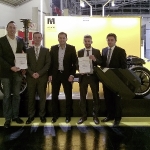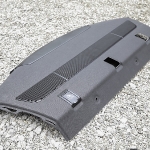Weighing just 13.9 kg, the carbon-fiber torque tube in the new Mercedes AMG-GT R is 40 percent lighter than the already weight-optimized aluminum component in the Mercedes AMG GT. On October 18, 2016, the innovative carbon-fiber composite component won the MATERIALICA Design+Technology Silver Award in the “Product” category. Daimler AG’s microsandwich won the Silver Award in the “CO2 Efficiency” category. Featuring eco-friendly source materials, a synergetic layer structure and a highly efficient production process, the new material system opens up tremendous potential for lightweight design in the vehicle interior along with weight savings of up to 50 percent per component.
CFRP torque tube
What impressed the panel of judges about the CFRP torque tube was that the main tubular shell, together with the heavily loaded connecting flanges, now consists of a single monolithic unit. Marking a new milestone in composite production, the absence of metallic connecting flanges paves the way for extremely lightweight design. The carbon-fiber composite component is manufactured by the economically efficient RTM process (Resin Transfer Molding). Innovative use is made of ultra-high-strength, highly rigid carbon fibers from the aviation sector to ensure that all loads are safely absorbed.
The new carbon-fiber torque tube allows a highly direct as well as extremely flexurally resistant and torsionally stiff transaxle-type connection between engine and transmission, making for favorable driving dynamics. The structural component thus guarantees an exceptionally direct response while contributing to a balanced weight distribution in the vehicle. Together with the drive shaft, which is likewise made of CFRP, the monolithic carbon-fiber housing can easily handle the huge torque of 700 Nm from the 585 hp Mercedes AMG-GT R. The torque tube not only absorbs the high forces and torque during vehicle operation, but can also withstand the dynamic load cycles and peak loads that come with a sporty driving style. This outstanding example of innovation is equally impressive when loaded to the limit, thanks to its benign failure behavior with no breakaway or buckling. As the vibration characteristics of the drive shaft, which is likewise made from a carbon-fiber composite, are optimally tuned to the torque tube, this guarantees that the highest standards of NVH (Noise Vibration Harshness) are met.
The innovative fiber-composite component was developed under the leadership of Mercedes AMG in close collaboration with the materials specialists from Daimler Research and the fiber-composite supplier ACE GmbH.
Microsandwich
Whether parcel shelf or other trim parts – the innovative microsandwich from Daimler AG impresses with its versatile application potential and thermal-insulation properties. Weight savings of up to 50 percent per component are possible. At the same time, the low use of materials halves both the CO2 emissions and the energy demand during production. The core of the sandwich is formed of a thermoplastic foam core, embedded in a surface layer of hybrid needle felt. Such a layer structure offers ideal forming properties for the production of numerous components for vehicle interiors. The microsandwich composite is manufactured by a one-shot process. In a single operation, molding tools with short cycle times take care of the forming of the temperature-controlled sandwich composite, the consolidation of the hybrid needle felt and the application of the decoration, together with joining of the individual layers, edge sealing and component trimming. Over 20 patents on material composition, manufacturing processes and design principles have already been applied for.
Caption nr.1: From left: Manuel Zwick, Mercedes-AMG GmbH, Christopher Werner, ACE GmbH, Fabio Utzeri, Daimler AG, Christoph Menzel, Daimler AG, Benno Stamp, Daimler AG – © Daimler AG
Caption nr.2: Carbon-fiber torque tube in the Mercedes AMG-GT R – © Daimler AG
Caption nr.3: Intelligent lightweight design of interior – © Daimler AG













